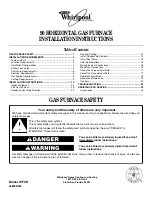
4
■
All models are suitable for closet or utility room installation.
Utility room installation requires:
A door opening large enough for the widest part of the
furnace.
A door opening large enough to remove/replace any other
appliance located in the utility room, such as a water heater.
Any other appliances arranged so that each appliance can be
removed/replaced without disturbing the furnace.
■
In a residential garage, a gas-fired furnace must be installed
so the burner(s) and the ignition source are located not less
than 18 in. above the floor. The furnace is to be located or
protected to avoid physical damage by vehicles.
■
If the furnace is to be installed in an attic or other insulated
space, it must be kept free and clear of insulating materials.
Installation Clearances
■
All servicing and cleaning of the furnace can be performed
from the front (side of the furnace where the controls and the
combustion blower are located). Provide at least an 18 in.
clearance in the front for servicing. Where servicing
clearances are greater than clearances to combustibles,
servicing clearances take precedence.
■
For the minimum clearances to combustibles required for
construction, servicing and proper unit operation see the
Minimum Clearances to Combustibles chart.
Minimum Clearance to Combustibles Chart
Suspended Installation Requirements
These models may be installed as suspended units. These
furnaces are not designed for direct attachment of suspension
rods to the furnace casing.
■
The suspending means must be field fabricated, and should
consist of two “cradles” made by attaching two rods to a
length of angle iron or suitable gauge steel.
■
Locate the cradles so that they are as close as possible to the
ends of the furnace (this will provide access for removal of
major components such as the blower assembly).
■
Provide enough clearance between the suspension rods and
the furnace to allow removal of access panels.
High Altitude Installations
■
This furnace is approved for operation at altitudes from 0 to
4,500 feet above sea level without any required modifications.
■
From 4,500 to 7,500 ft, the gas manifold pressure needs to be
adjusted according to the information shown in the Manifold
Pressure vs. Altitude charts.
IMPORTANT:
For installations above 7,500 ft, the furnace input rate is to be
reduced per the requirements of the National Fuel Gas Code
(ANSI Z223.1/NFPA 54, latest edition), at the rate of 4 percent for
each 1,000 feet above sea level.
The furnace is not recommended for installation above 10,000 ft.
Installation Configurations
The furnace must be installed in a horizontal position with right to
left airflow as viewed from the front side (the front side is the side
containing the gas control valve). See “Airflow Conversion”
section.
The furnace may be converted for horizontal installation with left
to right airflow. See “Airflow Conversion” section.
IMPORTANT: The conversion should take place before the
furnace is placed in its final location.
Unit Sides
0"
Rear of Unit
0"
Front of Unit
(side with gas control valve)
2"
Flue Pipe
0"
Plenum Top
1"



































